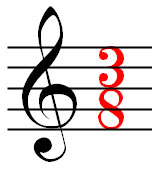All performers experience a certain degree of stage fright. Standing in front of a room full of people is bound to intimidate anyone! Your pulse will rise and your hands may sweat, but there is nothing to worry about; it’s all natural behavior. This article (and video) will provide some tips on how to deal with this common problem that nearly every performer faces.
Stage fright is merely a normal physiological response dating back to the fight or flight response during prehistoric times. While these metabolic and stressful reactions aren’t necessary for a modern society, they aren’t going away anytime soon. In other words, you have to deal with them. You may learn to harness this energy in positive ways – but how is this possible?
There is a recurring dream I have where I am playing piano in front of a large audience. I am performing for memory when I realize that I haven’t finished learning the rest of the piece! It’s more of a nightmare, really.
This brings us to the first step in overcoming stage fright, being prepared.
Prepare like crazy! You never want to be in front of an audience unprepared; it’s suicide. Preparation enables you to relax and enjoy the performance which makes the experience rewarding for the audience.
Another vital aspect of overcoming nerves is to practice performing.
Practicing by yourself is great but in order to prepare effectively, you will need to play for an audience. This is something that many musicians overlook, but it is absolutely essential. You can start out with low-pressure situations playing for friends and family. Play for anyone who will listen. Treat it like a public performance. Start with smaller groups – even one person can be enough at first. Gradually build your way up to larger audiences. This also enhances the effectiveness of your practice. You will spot problem areas to focus on in practice. Also, you will get a feel for the pacing of your program.
You must prepare for a performance both physically and mentally.
There are a number of things you can do physically to prepare yourself. Being well rested is certainly important. However, you may not want to deviate from your normal routine too much. It’s a good idea to stay away from caffeine and sugar right before your perform since both can make you jittery which can have an adverse effect on your playing. It’s best to eat a balanced meal before the performance. Foods like bananas and rice are easy to digest. Make sure you time your meal so you aren’t too full or hungry during the performance.
Mental preparation is incredibly important for successful performing.
I’ve had times where I was running around all day before a performance – making calls, answering emails, making videos – and without a moment to spare I have to plop myself down and perform. How do I deal with that? The short answer is I think about my performance a great deal before the actual day of the concert. I spend a lot of time running through the performance in my mind, thinking not only about the music, but sensing the audience as well. Some people suggest blocking out the audience to avoid getting nervous; This can be a great mistake! In fact, a great exercise is to lie down with your eyes closed and imagine being on stage. Think about sitting down at the bench of the piano, looking at the logo on the front of the fallboard. Take a deep breath imagining that moment while sensing the audience around you! On the day of the actual performance, you will be prepared by taking a deep breath, looking at the fallboard, and rekindling the comfortable acceptance of the audience as you had earlier.
Performing can be a rich and rewarding experience for both the audience and the performer. As a performer, you can share your love of the music with the audience. In time you can learn to harness the nervous energy involved in performing and use it to your advantage – you may find yourself doing things you never thought possible! Thanks again for joining me: Robert@LivingPianos.com (949) 244-3729





 If you look at a piece of music one of the very first things you will see are two numbers – it almost looks like a fraction. Some common time signatures you have undoubtedly seen before are 4/4 or 3/8 , these are not just arbitrary numbers, and they have a very important role in the timing of the piece.
If you look at a piece of music one of the very first things you will see are two numbers – it almost looks like a fraction. Some common time signatures you have undoubtedly seen before are 4/4 or 3/8 , these are not just arbitrary numbers, and they have a very important role in the timing of the piece.